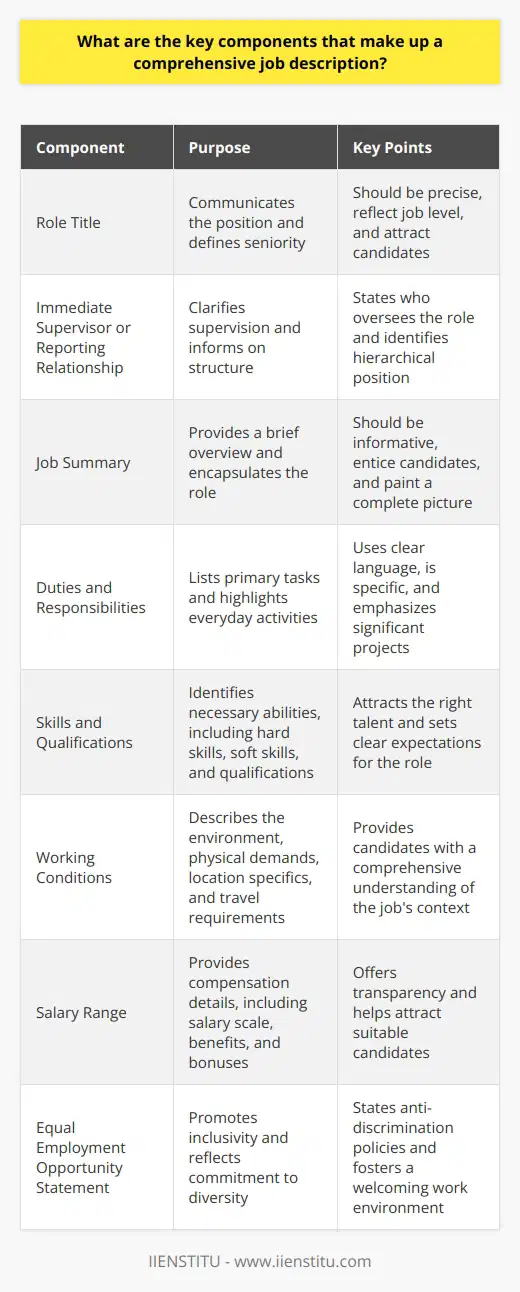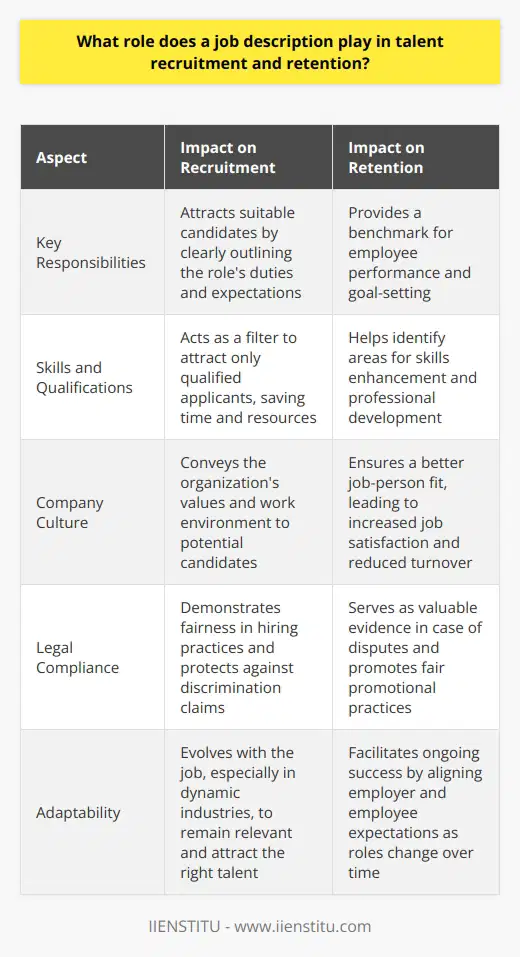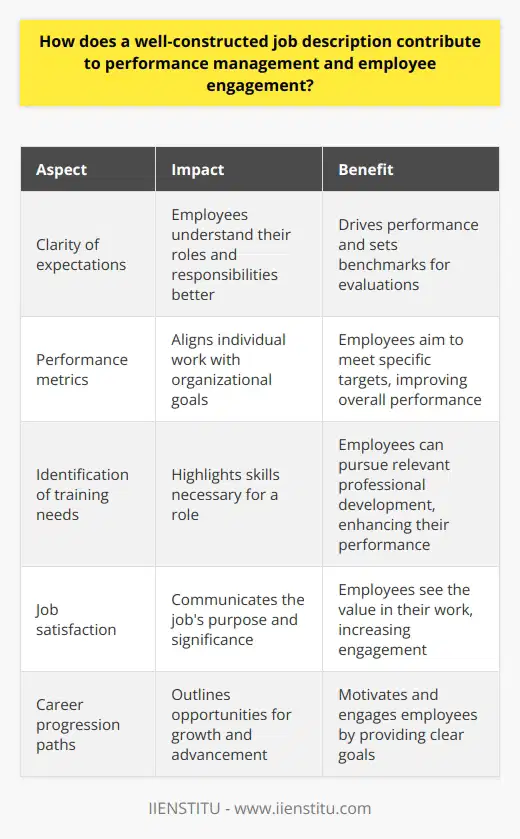
In today's highly competitive job market, creating an accurate and compelling job description is crucial for attracting and retaining top talent. A job description serves more than just a clerical function; it is the bridge between an organization's needs and the potential employee's understanding of his or her role.
This post is intended to dissect the significance of a job description meticulously, offering insights into its composition, its relevance in the recruitment and management process, and the art of writing one effectively. By embracing an expert approach and providing comprehensive knowledge, this article navigates the intricacies of job descriptions and the profound impact they have on the operational success of a business.
The Components of a Job Description
Job Title - Importance and Examples
The job title is the first point of engagement for prospective candidates. This element should encapsulate the essence of the position succinctly and accurately, avoiding exaggerated titles that might confuse or mislead applicants. For instance, a title like "Senior Sales Executive" clearly defines both the level and the main focus of the role.
On the other hand, vague titles such as "Sales Wizard" are less transparent and could deter serious candidates or those looking for a well-defined career path.
Job Summary – Explanation and Examples
A job summary acts as a brief introduction to what the position entails. It should provide an overview that touches on key aspects such as the main objectives of the role, how it fits into the larger organizational structure, and the impact it has on business operations.
An effective job summary for a Project Manager might state: "The Project Manager will oversee coordinated project portfolio management, ensuring that projects deliver on-time, within scope and budget, and drive our strategic business objectives."
Primary Duties and Responsibilities - Importance and Examples
The section covering primary duties and responsibilities is the core of the job description. It outlines the tasks the employee is expected to perform on a regular basis. Clarity is paramount here, as this not only guides the applicant's understanding of daily duties but also serves as a cornerstone for performance evaluations.
An example could be: "The Marketing Coordinator will develop campaign strategies, manage social media content calendars, and analyze market research to improve effectiveness."
Qualifications and Skills - Explanation and Examples
This component defines the experience level, educational background, technical proficiencies, and soft skills required for the position. For a position such as an IT Analyst, this might include a Bachelor's degree in Computer Science, proficiency in database management, strong analytical skills, and the ability to communicate complex information succinctly.
Physical Demands and Work Environment - The Necessity and Examples
A thorough job description also addresses the physical demands of the job and the work environment. This could encompass lifting requirements, exposure to certain chemicals, or the need for prolonged standing or sitting. For instance, a Warehouse Operative job description might note the requirement to "regularly lift and/or move objects weighing up to 50 lbs" and "work in a fast-paced environment with temperature changes."
The Role of a Job Description in Employee Recruitment
Helps to Attract the Right Candidates
When a job description is meticulously crafted with the right keywords, such as "hr online course" or "online certification courses," it aligns the job with current industry standards and expectations. This precision helps in attracting candidates who are equipped with the necessary qualifications and who are more likely to be a good fit for the role, which can, in turn, reduce the attrition rates and improve the quality of hires.
Helps Candidates Understand Their Role and Expectations
A clear and concise job description provides candidates with a deeper understanding of what will be expected from them, should they be hired. It sets the stage for the entire employment relationship, laying the groundwork for the candidate's integration into the company's culture and work processes. It removes ambiguity, allowing individuals to self-assess their suitability for a job before applying.
Facilitates the Interview Process
A well-developed job description is a valuable tool in the interview process. It allows interviewers to devise questions that are directly applicable to the role's requirements. Moreover, it provides a framework against which a candidate's responses and skills can be evaluated, leading to a more objective and effective selection process.
The Role of a Job Description in Employee Management
Provides Clear Expectations for Employees
Once hired, employees rely on their job descriptions to understand what is expected of them. These documents provide a clear directive on deliverables, priorities, and performance standards, hence promoting accountability and minimizing misunderstandings about job roles and responsibilities.
Serves as a Reference Point for Performance Reviews
During performance reviews, a job description offers a baseline to measure an employee's work against predetermined expectations. It forms a non-biased reference that managers can use to assess achievements, identify areas for growth, and guide discussions about career progression with employees.
Helps in Identifying Training Needs
Job descriptions can highlight gaps in an employee's skills or knowledge, guiding decisions on what online certification courses or other skill enhancement programs may be required. By comparing an employee's current proficiency to the job's needs, organizations can tailor training and development plans to address specific requirements, ultimately fostering professional growth and competence.
Writing Effective Job Description
Start with a Clear Job Title
A job title should be precise, reflective of the role's duties, and in line with industry norms. It must be easily recognizable and understandable, so that it resonates with the appropriate pool of candidates and confers the appropriate level of seniority.
Be Specific in Outlining Duties and Responsibilities
The duties and responsibilities listed should be specific, measurable, and exhaustive, providing a clear picture of what the day-to-day role entails. These should align with the strategic direction of the department and the company as a whole, expressing both the immediate tasks and the larger-scale contributions expected from the role.
Highlight Necessary Qualifications and Skills
Listing necessary qualifications and skills not only helps in filtering applications but also sets the tone for the caliber of work expected. This section should cover education, experience, technical and soft skills, and any other relevant certifications, such as an hr online course that might showcase a candidate’s commitment to their professional development.
Use Positive and Inviting Language
The language employed in a job description can dramatically affect its appeal. Adopting a positive and inclusive tone can make a position more attractive, inviting candidates to envision themselves as a part of a dynamic and welcoming workplace.
Provide a Brief Overview of the Company Culture
Providing insight into the company's culture can significantly differentiate a job description. Detailing the company’s environment, values, and mission invites potential candidates to connect on a cultural and emotional level, which might encourage them to take the step to apply.
Do's and Don'ts of Writing a Job Description
The Importance of Being Detailed but Not Overly Complex
A job description should encompass all facets of the role without becoming overwhelming. It should avoid jargon and complex language that can confuse candidates or make the role seem inaccessible.
Avoiding Discriminatory Language
Inclusivity should be a hallmark of every job description. Employers must ensure that the language used is free of bias and does not discriminate against any group. This includes avoiding gender-coded words and respecting diversity in all its forms.
Maintaining Compliance With Employment Laws
Compliance with local, state, and federal employment laws is non-negotiable. Job descriptions should adhere to these regulations to avoid legal repercussions and to ensure fair hiring practices.
Regularly Updating Job Descriptions for Accuracy
Roles evolve, and so should job descriptions. Regular updates ensure that they remain accurate, relevant, and reflective of the position's current demands. This is critical for maintaining clarity and continuing to attract well-matched candidates.
Case Study: The Impact of a Well-Written Job Description
Presentation of Real-World Example
Consider the case of a technology start-up that revamped its job descriptions to better articulate the roles and anticipated contributions of its staff. By including specific software skills, highlighting the importance of collaboration within cross-functional teams, and emphasizing opportunities for career growth, the company experienced a notable surge in the quality of applicants.
Discussion of the Results
The tangible outcome was a lower turnover rate, improved employee satisfaction, and enhanced performance throughout the company. The precision and appeal of the job descriptions played a pivotal role in this transformation, illustrating the significant impact a well-crafted job description can have.
Recap of Main Points Discussed
To summarize, a comprehensive job description is integral to the recruitment process and ongoing employee management. It serves as a focal point for attracting qualified candidates, setting expectations, guiding performance reviews, and identifying training needs. With careful attention to language, compliance, and inclusivity, it becomes a powerful tool for workforce optimization.
Encouragement for the Targeted Application of a Well-Drafted Job Description
Organizations are encouraged to recognize the importance of investing time and resources into crafting job descriptions that not only meet the immediate needs of a vacancy but also align with the company’s long-term strategic goals. We’ve explored the myriad ways in which a job description can influence the success and culture of a business, and we hope this exploration serves as a call to action for all employers.
Frequently Asked Questions
What are the key components that make up a comprehensive job description?
Job descriptions set expectations. They map responsibilities. They attract candidates. A good one informs. It outlines the role. It guides applicants. A comprehensive job description includes key components. Each part serves a purpose. Together, they paint a complete picture.
Role Title
The title communicates the position. It should be precise. It defines seniority. It reflects the job level.
Immediate Supervisor or Reporting Relationship
Clarify supervision. State who oversees this role. It informs on structure. It identifies hierarchical position.
Job Summary
Include a brief overview. It encapsulates the role. It should be informative. It should entice candidates.
Duties and Responsibilities
List primary tasks. Use clear language. Be specific. Highlight everyday activities. Emphasize significant projects.
Core Responsibilities
Define key obligations.
Focus on essentials.
Keep it succinct.
Additional Duties
Mention secondary tasks.
Include occasional assignments.
Show the role's scope.
Skills and Qualifications
Identify necessary abilities. Include:
Hard Skills
State technical competencies.
Mention required certifications.
List relevant software proficiency.
Soft Skills
Emphasize communication.
Note leadership qualities.
Highlight teamwork importance.
Qualifications
Specify academic credentials.
Note years of experience.
Mention industry expertise.
Working Conditions
Describe the environment. Mention physical demands. State location specifics. Highlight travel requirements.
Salary Range
Provide compensation details. Include the salary scale. Discuss benefits. Offer information on bonuses.
Equal Employment Opportunity Statement
Promote inclusivity. State anti-discrimination policies. Reflect commitment to diversity.
A comprehensive job description serves many. It helps employers. It attracts the right talent. It sets clear expectations. Keep it simple. Make it thorough. Ensure it is accessible. Reread for clarity. A good description makes all the difference.

What role does a job description play in talent recruitment and retention?
The Importance of Job Descriptions
Job Description in Recruitment
A job description serves as a cornerstone in recruitment. It outlines the role's key responsibilities. Moreover, it defines the skills and qualifications required. Job descriptions also convey the company culture. They act as a filter to attract suitable candidates. This clarity simplifies the hiring process. Only qualified applicants tend to apply. Therefore, recruiters save time and resources.
Communicating Expectations
Clarity in job responsibilities is vital. It ensures candidates understand the role. They know what the company expects from them. This understanding prevents future performance issues. Clearly defined roles lead to better job-person fit. Hence, job satisfaction increases. And, as a result, employee turnover reduces.
Role in Retention
Once hired, job descriptions continue to play a key role. They provide a benchmark for employee performance. Descriptions help in setting achievable goals. Management and employees align on expectations. This leads to fewer misunderstandings. Job descriptions also facilitate personal growth. Employees see a clear path for career advancement.
Legal Compliance
From a legal perspective, job descriptions are critical. They protect both the employer and the employee. These documents act as a defense against discrimination claims. They show fairness in hiring and promotions. In the case of disputes, they serve as valuable evidence. Job descriptions are not static. They evolve with the job. Regular updates keep them relevant. This is especially important in dynamic industries.
Employee Development
The role of job descriptions in career development is undeniable. Employees refer to them for self-assessment. They identify areas for skills enhancement. Leaders also use them for coaching. This fosters professional development. And professional growth is key to employee retention.
In conclusion, job descriptions are fundamental. They ensure the recruitment of suitable candidates. They set the scene for ongoing success. Employer and employee alike rely on them. They serve as a guide, a legal document, and a development tool. Succinct but in-depth job descriptions are crucial. They enhance recruitment practices and employee retention strategies.

How does a well-constructed job description contribute to performance management and employee engagement?
Understanding the Role of Job Descriptions
Job Descriptions and Performance Management
A strong job description outlines expectations clearly. Employees understand their roles better. Clarity drives performance. It breaks down tasks and responsibilities. Workers then know what supervisors expect. This sets benchmarks for performance evaluations. Clear criteria make evaluating employee performance objective. Feedback becomes focused and actionable.
Performance metrics stem from job descriptions. These metrics align individual work with organizational goals. Thus, employees aim to meet these specific targets. Job descriptions aid in identifying training needs. They highlight skills necessary for a role. Employees can pursue relevant professional development. This improves their performance over time.
Enhancing Employee Engagement through Job Descriptions
Job descriptions can foster job satisfaction. They communicate the job's purpose and significance. Employees then see the value in their work. This enhances their engagement. An accurate job description helps match candidates to roles. It ensures skill alignment and cultural fit. Employees in well-matched positions tend to engage more.
Well-crafted job descriptions set career progression paths. Employees understand how they can grow. They see clear opportunities for advancement. This motivates and engages them. Job autonomy gets spelled out in the description. This encourages employees to take initiative. Engaged employees feel empowered. They contribute ideas and innovation.
The Impact on Organizational Success
Both performance management and employee engagement affect the bottom line. A well-constructed job description influences these areas strongly. It provides a foundation for aligned and motivated workers. Their productivity directly ties to organizational success.
Job descriptions are not mere formalities. They are strategic tools. They ensure employees understand their roles and deliver effectively. They engage workers by showing value and paths for growth. Organizations should invest in developing clear, detailed job descriptions. This investment pays off in better performance and greater engagement.



